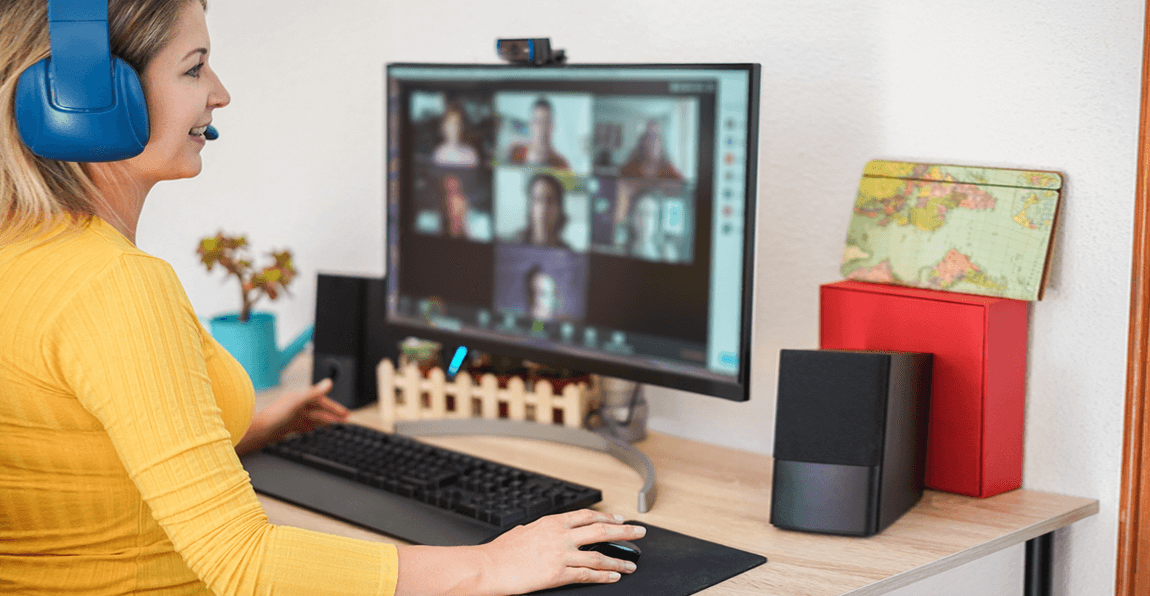
When working from home, it pays to have a dedicated workspace. Separating your personal from your work life promotes better productivity as well as a better work/life balance. The same is true for your virtual workspace. You need to create an environment that replicates the office experience, complete with the tools you need and with minus distractions from social media and personal email.
According to the Gartner 2020 Digital Workplace Survey, 68 percent of C-level executives have become actively interested in creating a virtual workspace for remote employees ever since the COVID-19 outbreak. The need for alternatives to in-person meetings and face-to-face interaction has elevated demand for remote work platforms from “nice to have” to “must-have.”
At the center of any virtual workspace is a suite of software-as-a-service (SaaS) personal productivity and communications tools. The hardware used to support the virtual workspace is evolving as well from Bring Your Own Device (BYOD) to Bring Your Own Thing (BYOT) as more consumers start using Internet of Things (IoT) devices such as fitness watches, virtual reality headsets, smart lighting, and other integrated devices. New smart workspaces are creating new ways to work and ways to improve productivity powered by desktop-as-a-service (DaaS) platforms.
Create a Dedicated Workspace
Before considering what you need in a virtual workspace, think about what you want from your physical home office. The notion of working remotely is not new. Well before the pandemic workers were telecommuting from the local Starbucks. With stay-at-home orders, however, remote work has become the norm, and more telecommuters find they perform better with a dedicated at-home work area.
Your work-from-home space should help you separate work time from family time. You need a quiet space that presents minimal distractions with a dedicated workstation or desk and a comfortable chair. Keeping regular work hours and a predictable work schedule also helps with effective time management. The goal is to create a physical space and schedule that says, “I am at work.”
Of course, you will need the right technology as well, such as a personal computer or laptop, a reliable internet connection, and a phone, whether it’s a landline or your mobile phone. Optional office tools that you may need include a printer, scanner, file cabinet, storage shelves, adequate lighting, and headphones or a door you can close for privacy.
Deploy a Virtual Desktop Workspace

Creating a physical workspace is the first step. Now consider what you need in a virtual workspace.
To minimize distractions and maximize productivity you want all your workplace software and collaboration tools in a single interface. Ideally, your company has adopted a standardized virtual workspace as part of its work-from-home strategy. It’s easier to work together and share information if the entire company is using the same set of collaboration tools.
Any remote work strategy requires a secure internet connection, so most companies are providing a virtual private network (VPN) connection, either through their own data center or through a hosted service. A VPN client application is loaded on the user’s computer to provide a secure connection to business applications. You will need your own security for your home network as well. Be sure to use a password-protected home router to prevent wireless eavesdropping. Also, keep your passwords up to date and be sure to use antivirus and malware software to protect your home system.
As part of your virtual officer desktop, you require a DaaS applications such as email, chat, file sharing, shared calendars, and other collaboration tools. Some of those tools will have similar functions, so determine how to use them to best advantage. Email, for example, is valuable if you want to share more detailed exchange where you want a thread of what was discussed, versus real-time tools such as chat that give you immediate access to coworkers. Most of these collaboration tools, such as email and shared calendars, will be familiar while others, such as video conferencing, may take some getting used to as part of your virtual desk space.
Shared access to business applications such as CRM, ERP, task management, and contract management software will also improve productivity. Establishing clear guidelines related to data entry and file-sharing will keep everyone on track. For example, using a central data repository for file sharing rather than sending email attachments, or having a common procedure to enter customer notes makes sure everyone on the team has access to the same information.
Standardizing on a common collaborative platform that consolidates all the communications and business software you need creates a common virtual workspace so everyone has the same tools.
Working from home isn’t for everyone. Many people like the structure of an office and find it hard to work from home without being distracted. A dedicated physical and virtual workspace can help you emulate the work experience at home and having a common set of communications and collaboration tools also can help you stay connected to coworkers and combat the isolation of work from home.
The pandemic has forced the experiment of work from home on many companies and what they are discovering is that having a shared technology interface makes it easier for everyone to come together to get the work done. Even after the COVID crisis has passed, you can expect to see more companies embrace work-from-home strategies with shared DaaS applications to increase productivity and cut operating costs.
Discover how PeopleOne can transform your organization
Request a DemoHR and Comms Guide: How to Turn Your Intranet into a Highly Engaged and Productive Platform
Download Ebook









